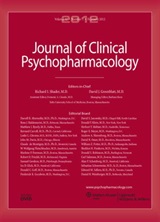Neue Publikation im Journal of Clinical Psychopharmacology

Abstract: The objective of the present naturalistic study was to assess the differential effects of opioid detoxification with methadone or buprenorphine on activity, circadian rhythm, and sleep. Forty-two consecutive inpatients with opiate addiction were switched to either methadone or buprenorphine and gradually tapered down over the course of 2 to 3 weeks. There were no significant differences in comedication (lofexidine, quetiapine, and valproic acid) between the methadone and buprenorphine groups. Patients in the methadone group showed 11% lower activity and were 24 minutes phase delayed as compared with buprenorphine-treated patients, whereas the latter had 2.5% lower sleep efficiency and 9% shorter actual sleep time. These significant group differences were most pronounced for the lowest doses (e20% of maximum individual daily dose, ie, at the end of withdrawal representing late withdrawal effects). Furthermore, for the total sample, we found a significant decrease in the relative amplitude of the sleep-wake cycle and worsening of all actigraphic sleep parameters from the higher (100% to 20%) to the lowest doses (20% to 0%). The acrophase of the circadian rhythm displayed a phase advance (j88 minutes) from the highest (100% to 80%) to the lower doses (80% to 0%) in methadone-treated patients. Opioid tapering with methadone or buprenorphine leads to characteristic changes of the rest-activity cycle, but further study is required to validate these results.
Pjrek E, Frey R, Naderi-Heiden A, Strnad A, Kowarik A, Kasper S, Winkler D (2012) Actigraphic measurements in opioid detoxification with methadone or buprenorphine. Journal of Clinical Psychopharmacology 32:75-82 (Impact Factor 2012 = 3.513)